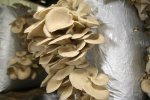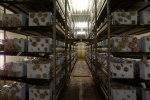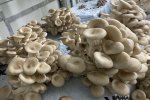
Interview
New sporeless oyster mushrooms
The development of a cultivatable sporeless oyster mushroom by Wageningen researchers in 2004 put an end to the need for growers to protect themselves against allergenic oyster mushroom spores. But just like other mushrooms, this strain is theoretically also vulnerable to genetic defects. To offer growers an alternative, Wageningen University & Research (WUR) has developed a new sporeless strain. This new, improved strain is now being tested in practice by growers.
Growers are used to the current variety, but they will also benefit from having more choice, as it makes them less vulnerable.
The Dutch mushroom sector is under pressure from fierce competition from abroad. When Johan Baars started researching mushrooms back in 1993, there were still as many as a thousand button mushroom growers in the Netherlands. Now there are only about eighty remaining, although together they produce more mushrooms than the thousand at that time. “The margin on mushroom cultivation is low, so growers were forced to scale up. Also, some growers decided to look for a niche market.”
Growth market
Oyster mushroom cultivation is one such niche market – and a growing market, too, with the increasing popularity of the oyster mushroom in the culinary world. The finely chopped cap of the mushroom goes well in risotto, pasta dishes, or wild mushroom soup. More and more growers are therefore making room in their cultivation schedules for the oyster mushroom, which attracts higher margins than the average button mushroom. Until well into the last century, oyster mushroom cultivation was problematic, Baars explains. “There were a few oyster mushroom growers in the Netherlands, but they had to protect themselves against the billions of airborne spores spread by the mushrooms. To prevent allergic reactions in the lungs, they had to wear pressurised helmets, which was unpleasant. On top of that, the vast quantities of airborne spores would clog the air filters, which meant higher energy bills. And yields were disappointing, too; new nurseries achieved impressive yields, but after a few months the numbers would collapse, most likely because the spores spread diseases.”
Defective gene
In 1997, Baars and his colleagues started researching the possibility of cultivating a sporeless oyster mushroom. “In 1959, the American researcher Block found an oyster mushroom on a tree, which then made its way to a German lab. From that one mushroom, the German researcher Eger managed to cross a variant that produced no spores. We now know that this is due to a defective gene. We started breeding this variant in 1997. We wanted to grow an oyster mushroom with a large, fleshy cap and an attractive colour. The first trials were not particularly successful, producing small bundles of oyster mushrooms with small caps and long stems. But by 2004 we had developed a lovely new variety.”
Commercial success
With a combination of trial and error as well as skill, the industry has succeeded in turning variations of this mushroom into a commercial success. A good example is the popular SPOPPO, a strain that eliminates the risk of respiratory problems in workers and the spread of infections via its own spores. Ninety percent of growers in North-Western Europe now grow the improved variety. The downside of this success is that oyster cultivation is highly dependent on this one sporeless strain, Baars believes. “This is risky for the sector. Falling back on a strain that does give off spores is not an option because growers are no longer equipped to deal with spore pressure.”
Cultivation of SPOPPO
Sixteen new variants
WUR worked on breeding new sporeless strains for six years. With good results, Baars says. “We have developed sixteen variants which we believe have potential. These variants are ready for testing by growers. The trials we carried out in our own nursery were very promising. Growers are curious and there is a lot of interest in trying out the new variants.”
If the new variants turn out to be similar in quality to the oyster mushroom currently available in the shops, growers will grow them, Baars predicts. “Growers are used to the current variety, but they will also benefit from having more options, as that makes them less vulnerable. It might already happen in a year or two.”


